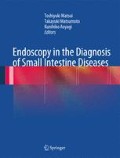Abstract
The advent of capsule endoscopy (CE) and balloon-assisted endoscopy (BAE) is revolutionizing the diagnosis of small intestinal disease, which has hitherto relied on radiographic methods. Endoscopic examination offers a range of advantages, and its future development and widespread adoption are expected. Conversely, the use of radiography can be anticipated to decline still further. However, it is unlikely that it will ever be possible to diagnose small intestinal disease using endoscopy alone, without any need for radiography. The small intestine is bordered on the proximal end by the esophagus, stomach, and duodenum, and on the distal end by the large intestine, and is the longest organ in the human body. These anatomical characteristics mean that it is no easy task to observe the small intestine in its entirety, even with the help of capsule and balloon endoscopy. Endoscopy may also encounter problems due to stenosis, adhesions, or unusual dispositions following surgery. From the disease perspective, although malignant conditions are less frequent compared with other parts of the gastrointestinal tract, chronic inflammatory disorders such as Crohn’s disease and lesions associated with systemic disorders are common. In such disorders, grasping the entire picture and describing responses to treatment and the natural course objectively is more important than observing localized areas in detail. Radiography is clearly superior to endoscopy in terms of grasping the entire picture and objectively describing areas or lesions. If imaging is performed properly and interpreted by a competent practitioner, radiography will still have an important role to play in the diagnosis of small intestinal disease. Mechanical advances have also improved visualization by CT and MRI, and these modalities have recently been used for procedures such as enterography and enteroclysis. Unlike regular radiography, these methods also provide information external to the lumen, and have the advantages of being performable even if intestinal tract obstruction is present as well as minimal invasiveness, meaning they will continue to hold important places in diagnostic imaging of the small intestine.
Access this chapter
Tax calculation will be finalised at checkout
Purchases are for personal use only
References
Nakamura U et al. X-ray examination of the small intestine by means of duodenal intubation—double contrast study of the small bowel. Stom Intest. 1974;9:1461–9.
Yao T. Double contrast enterolysis with air. In: Freeny PC, Stevenson GW, editors. Malgulis and Burhenne’s alimentaly tract radiology. St Louis: Mosby; 1994. p. 548–51.
Herlinger H. Enteroclysis technique and variations. In: Herlinger H, Maliglinte DDT, Birnbaum BA, editors. Clinical imaging of small intestine. 2nd ed. New York: Springer; 1999. p. 95–123.
Yorioka M et al. Newly devised small bowel sonde for air contrast barium study after enteroscopy. Stom Intest (in Japanese). 2011;46:500–6.
Colombel JF et al. Quantitative measurement and visual assessment of ileal Crohn’s disease activity by computed tomography enterography. Gut. 2006;55:1561–7.
Paulsen SR et al. CT enterography as a diagnostic tool in evaluating small bowel disorders: review of clinical experience with over 700 cases. Radiographics. 2006;26:641–57.
Low RN et al. Crohn disease with endoscopic correlation: single-shot fast spin-echo and gadolinium-enhanced fat-suppressed spoiled gradient-echo MR imaging. Radiology. 2002;222:652–60.
Koilakou S et al. Endoscopy and MR enteroclysis: equivalent tools in predicting clinical recurrence in patients with Crohn’s disease after ileocolic resection. Inflamm Bowel Dis. 2010;16:198–203.
Umschaden HW et al. Small-bowel disease: comparison of MR enteroclysis images with conventional enteroclysis and surgical findings. Radiology. 2000;215:717–25.
Negaard A et al. Magnetic resonance enteroclysis in the diagnosis of small-intestinal Crohn’s disease: diagnostic accuracy and inter-and intra-observer agreement. Acta Radiol. 2006;47:1008–16.
Author information
Authors and Affiliations
Corresponding author
Editor information
Editors and Affiliations
Rights and permissions
Copyright information
© 2014 Springer Japan
About this chapter
Cite this chapter
Hirai, F. (2014). Small Intestinal Radiography. In: Matsui, T., Matsumoto, T., Aoyagi, K. (eds) Endoscopy in the Diagnosis of Small Intestine Diseases. Springer, Tokyo. https://doi.org/10.1007/978-4-431-54352-7_2
Download citation
DOI: https://doi.org/10.1007/978-4-431-54352-7_2
Published:
Publisher Name: Springer, Tokyo
Print ISBN: 978-4-431-54351-0
Online ISBN: 978-4-431-54352-7
eBook Packages: MedicineMedicine (R0)

